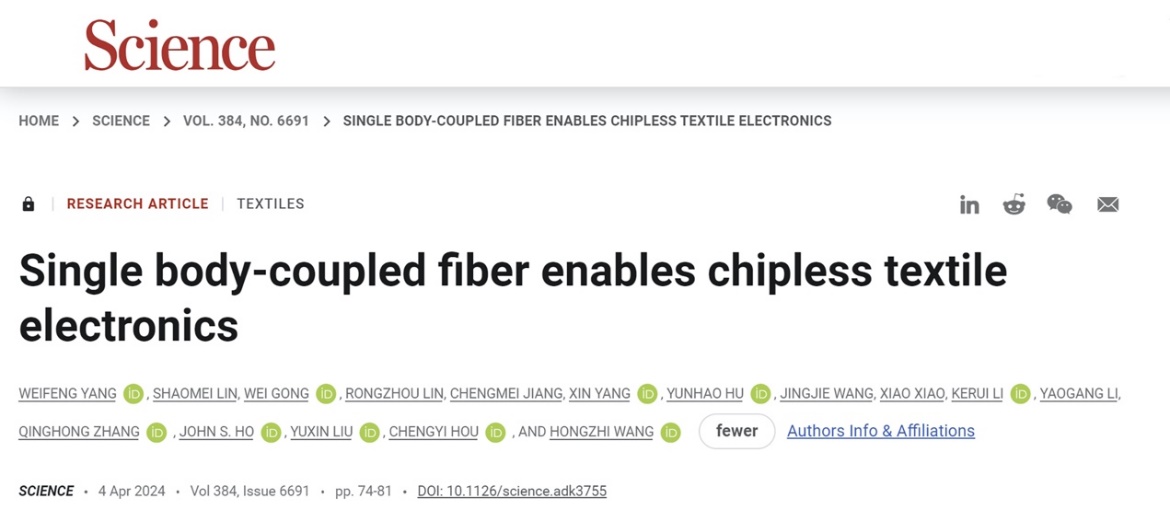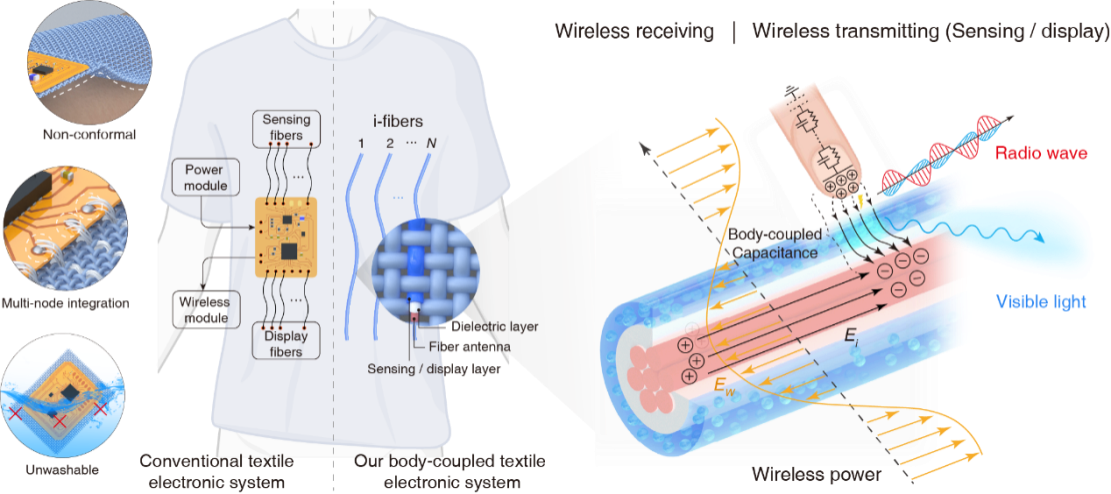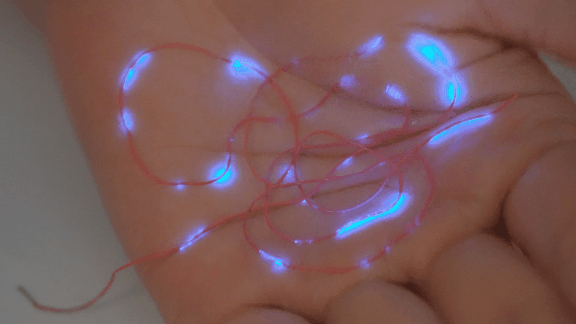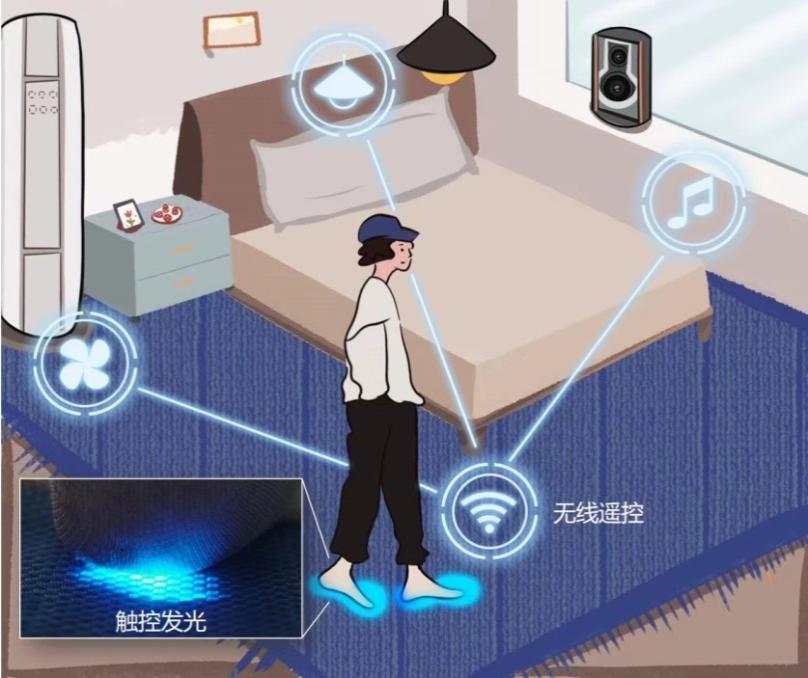Have you ever seen fibers that can generate light and electricity when worn? What functions do you expect from smart wearable devices? How do you envision future human-computer interaction scenarios?
On April 5th, the Advanced Functional Material Group of the College of Materials Science and Engineering at Donghua University published a research paper titled "Single Body-coupled Fiber Enables Chipless Textile Electronics" in Science. The study proposed an energy interaction mechanism based on "human-body coupling" and successfully developed a new type of smart fiber that integrates functions such as wireless energy harvesting, information sensing, and transmission. The smart textile woven from this fiber can achieve human-machine interaction functions such as light emission display and touch control without chips and batteries. This breakthrough achievement opens up new possibilities for intelligent interaction between humans and the environment and has broad application prospects.
Yang Weifeng, a doctoral student at the College of Materials Science and Engineering, Donghua University, is the first author of the paper. Professor Wang Hongzhi and Researcher Hou Chengyi from the State Key Laboratory for Modification of Chemical Fibers and Polymer Materials (Donghua University), as well as Researcher Zhang Qinghong from the College of Materials Science and Engineering, Donghua University, are the corresponding authors of the paper. The research was led by Donghua University as the sole corresponding institution, with collaboration from the National University of Singapore and Anhui Agricultural University.


The continuous development of technology is making smart wearable devices a part of our lives, with an increasingly important role in areas such as health monitoring, remote medical care, and human-computer interaction. Compared with traditional rigid semiconductor components or flexible thin film devices, electronic textiles woven from smart fibers have better breathability and softness, and are considered ideal carriers for wearable devices. Currently, the development of smart fibers is mostly based on the "von Neumann architecture", which uses silicon-based chips as the information processing core to develop various electronic fiber functional modules, such as sensing fibers for signal acquisition, conductive fibers for signal transmission, luminescent fibers for information display, and power-generating fibers for energy supply. While these functional units can be combined to form fabric structures, this complex multi-module integration technology still faces a series of challenges. Current smart textiles still rely on chips and batteries, which are large in size, heavy, and rigid, making it difficult to simultaneously meet people's needs for textile functionality and comfort.

(Mechanism of action of "human-body-coupled" smart fibers and their comparison with traditional electronic textiles)
The study was conducted by a research team from Donghua University that proposed a novel intelligent fiber with a "non-von Neumann architecture", which effectively simplifies the hardware structure of wearable devices and smart textiles, optimizing their wearability. This work achieved the integration of energy harvesting, information sensing, and signal transmission functions into a single fiber, which was woven into smart textiles without relying on chips and batteries.
What is the mystery behind the fiber that can generate light and electricity without being plugged in? Electromagnetic fields and waves are everywhere in our daily life, making electromagnetic energy dispersed in the environment function as the wireless driving force of this new type of fiber. But how is this energy "transferred" to the fiber? The answer is our bodies. The team proposed that the human body can be a carrier for energy exchange, thus opening up a convenient energy "channel". The electromagnetic energy that would normally dissipate in the atmosphere is prioritized to enter the circuit composed of the fiber, human body, and the earth, thanks to this "unnoticed" principle, which promotes a new type of energy exchange mechanism called "human coupling". After adding specific functional materials, this new type of fiber will exhibit the "magical scene" of generating light and electricity simply by being touched by the human body.

(Schematic diagram of human body coupled electromagnetic energy harvesting)
This new type of fiber has a three-layer sheath-core structure, using commonly available materials on the market. The core layer is a fiber antenna (silver-plated nylon fiber) that induces alternating electromagnetic fields, the middle layer is a dielectric layer (BaTiO3 composite resin) that enhances electromagnetic energy coupling capacity, and the outer layer is a luminescent layer (ZnS composite resin) sensitive to electric fields. The raw material cost is low, and the processing of fibers and fabrics can be achieved using mature techniques, with the ability for mass production." said Yang Weifeng.



(Demonstration of touch-sensitive optical fibers with fabric and wireless game control)
The work also demonstrates several applications of this intelligent fiber based on the principle of human-body coupling: it achieves functions such as fiber touch-controlled lighting, fabric display, and wireless command transmission without chips and batteries. Researcher Hou Chengyi said, "This new type of fiber can be applied to daily textile products such as clothing and fabric decoration. When they come into contact with the human body, they can visualize sensing, interaction, and even highlight illumination through luminescence. At the same time, they can generate unique wireless signals for different postures and movements of the human body, thereby achieving wireless control for electronic products such as smart home appliances. These novel functions are expected to expand the application scenarios of electronic products and even change the way people live their smart lives."

(Prospects for smart living scenarios)
Our innovative achievement comes from the relentless pursuit of the unknown and the unremitting exploration of cultivating innovative talents. "Interdisciplinary integration is the new trend of scientific research and innovation. This research involves multiple disciplines such as materials, information, and textiles. We have always insisted on teaching according to their aptitude in student cultivation, providing differentiated guidance based on students' different interests, especially in encouraging and guiding students to focus on the academic frontier and carry out interdisciplinary integration and innovative research. Only in this way can we produce more breakthrough results," said Dr. Zhang Qinghong, the doctoral supervisor of Yang Weifeng.

(Some of the faculty and students from the advanced functional materials research group)
The breakthroughs in scientific research are the result of long-term accumulation. According to Professor Wang Hongzhi, the leader of the Advanced Functional Material Group at Donghua University, the group has been dedicated to the research of intelligent fiber materials and devices. Starting from the research on graphene conductive fibers in 2012, they developed electrochromic fibers in 2016, and then built the first production line for electrochromic and piezoelectric fibers in 2018, achieving continuous and large-scale preparation. Subsequently, the team successively developed sensing fibers, luminescent fibers, temperature-adjusting fibers for continuous preparation, and a series of achievements laid the foundation for deepening research in the field of intelligent fibers. "We will further study how to make this new type of fiber collect energy from space more effectively in the next stage of work and use it to drive more functions, including display, deformation, computation, artificial intelligence, etc. We believe that in the near future, smart clothing will embrace more application scenarios, people will become more powerful, and they will have better adaptability to the environment."
At the same time, Science also invited experts from the University of Illinois at Urbana-Champaign and the Massachusetts Institute of Technology to comment on and report on this achievement. The results are considered potential to change the way people interact with the environment and with each other, and have important inspirational significance for the development of functional fibers and the application of smart textiles in different fields. In terms of basic research, this smart fiber and textile can "unconsciously" collect a large amount of tactile data from the body without interfering with people's daily activities, thus making the physical information collection regarding the interaction between the human body and the outside world more efficient and convenient . This is expected to influence the development of basic models for research on human physical interaction.
Paper link: https://www.science.org/doi/10.1126/science.adk3755


